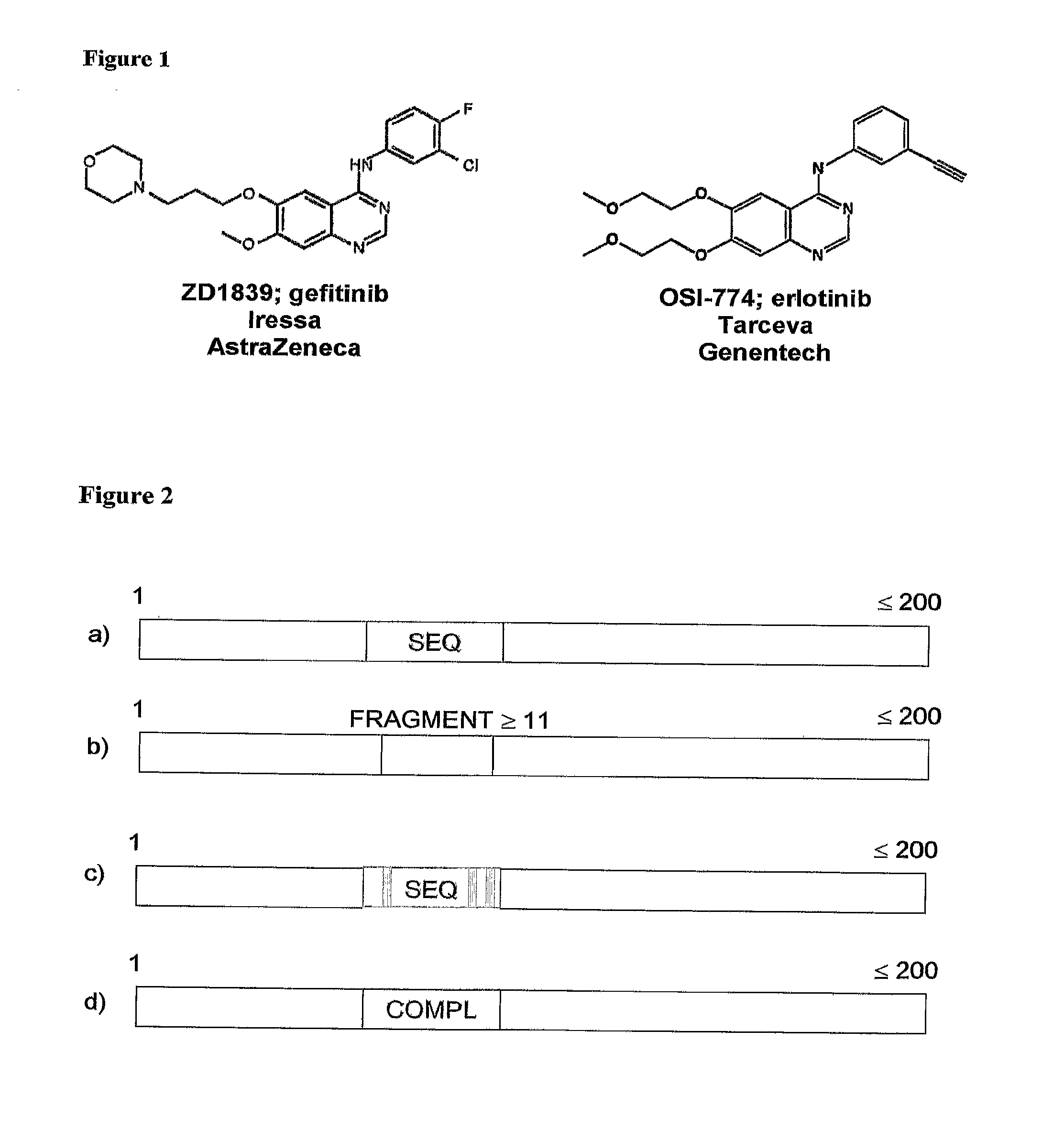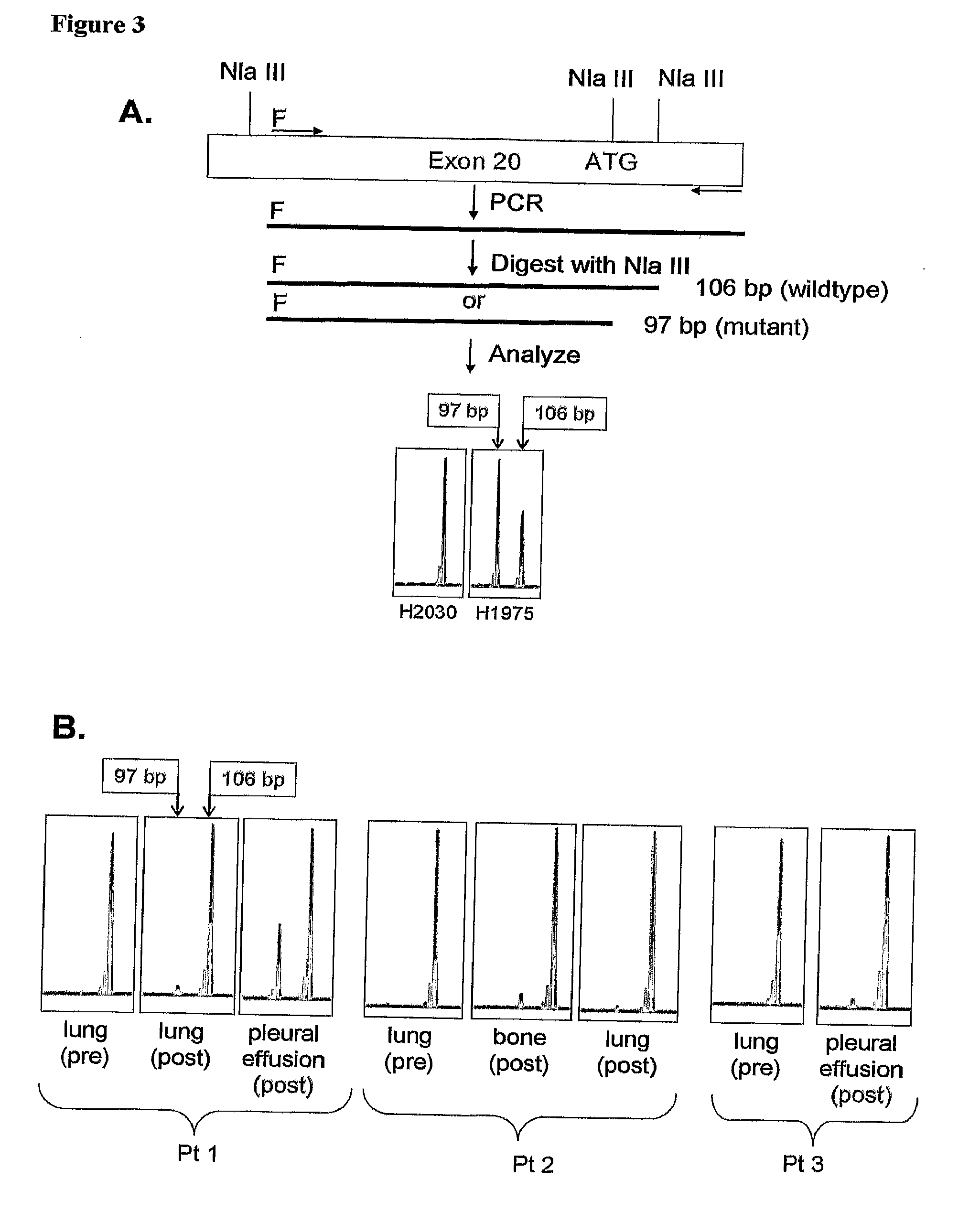Methods and Compositions for Detecting a Drug Resistant EGFR Mutant
a technology of egfr mutant and composition, which is applied in the field of methods and compositions for detecting a drug resistant egfr mutant, can solve the problems of patients that are refractory to further treatmen
- Summary
- Abstract
- Description
- Claims
- Application Information
AI Technical Summary
Benefits of technology
Problems solved by technology
Method used
Image
Examples
example 1
[0134]To confirm the presence of the EGFR T790M mutation, an allele-specific oligonucleotide PCR based assay (Guo, Z., Liu, Q. & Smith, L. M. Enhanced discrimination of single nucleotide polymorphisms by artificial mismatch hybridization. Nat. Biotechnol. 15, 331-335 (1997)) is performed by amplifying the mutant allele using one base mismatch PCR primers containing one 3′ end and a 3-nitropyrrole residue. PCR products are created with a 3′ mutant allele specific primer
(5′ CACCGTGCAGCTCATCAT 3′(SEQ ID NO: 12)or5′ CGAAGGGCATGAGCTGCG 3′(SEQ ID NO: 13))
containing the complement to the mutant base at the 3′ end and a 3-nitropyrrole residue upstream of the 3′ end. The mutant allele specific primer is capable of amplifying mutant DNA derived from frozen or paraffin-embedded tumors, but is unable to produce a product from normal DNA. At the same time, a wild-type (WT) 3′ primer
(5′ CACCGTGCAGCTCATCAC 3′(SEQ ID NO: 14)or5′ CGAAGGGCATGAGCTGCA 3′(SEQ ID NO: 15))
is able to amplify only normal wi...
example 2
Clonal Origin of the EGFR T790M Mutation
[0135]When careful tumor microdissection is performed in attempt to increase the relative percentage of tumor cells in any given sample, the ratio of the T:C alleles increases proportionately. The PCR is performed with one of the primers described in Example 1 and another primer amplifying in the contrary sense, so that a readily detectable fragment can be obtained for the EGFR sequence, either mutated or wild type, whose presence is being sought. The sequence of such primer can be easily designed by those of ordinary skill in the art. Results of such procedures demonstrate that the EGFR T790M mutation is clonal in origin.
example 3
Assay for the EGFR T790M Mutation in Genomic DNA
[0136]A method is provided for detecting EGFR T790M mutation whereby a restriction enzyme NlaIII is used to recognize the lack or presence of restriction site at the mutated codon. In this Example an assay is provided using a primer that spans the intron-exon boundary for exon 20. The fluorescence-based detection takes advantage of a PCR restriction fragment length polymorphism (PCR-RFLP) generated by the specific missense mutation. PCR amplification is performed with the exon-20-specific primers EGFR Ex20F (SEQ ID NO:4) and EGFR Ex20R (SEQ ID NO:5) (underlined in Table 4) spanning nucleotide 2369. Table 4 includes a portion (Seq ID No. 24) of the larger intron-exon 20-intron genomic sequence given in Table 3 (SEQ ID NO:3) from position 161904 to position 162970. The 3′ terminus of the intron upstream from exon 20 is shown in bold type.
TABLE 4. . . gtattttgaaactcaagatcgcattcatgcgtcttcacctggaaggggtccatgtgcccctccttctggccaccatgcgaagccacac...
PUM
 Login to View More
Login to View More Abstract
Description
Claims
Application Information
 Login to View More
Login to View More - R&D
- Intellectual Property
- Life Sciences
- Materials
- Tech Scout
- Unparalleled Data Quality
- Higher Quality Content
- 60% Fewer Hallucinations
Browse by: Latest US Patents, China's latest patents, Technical Efficacy Thesaurus, Application Domain, Technology Topic, Popular Technical Reports.
© 2025 PatSnap. All rights reserved.Legal|Privacy policy|Modern Slavery Act Transparency Statement|Sitemap|About US| Contact US: help@patsnap.com



